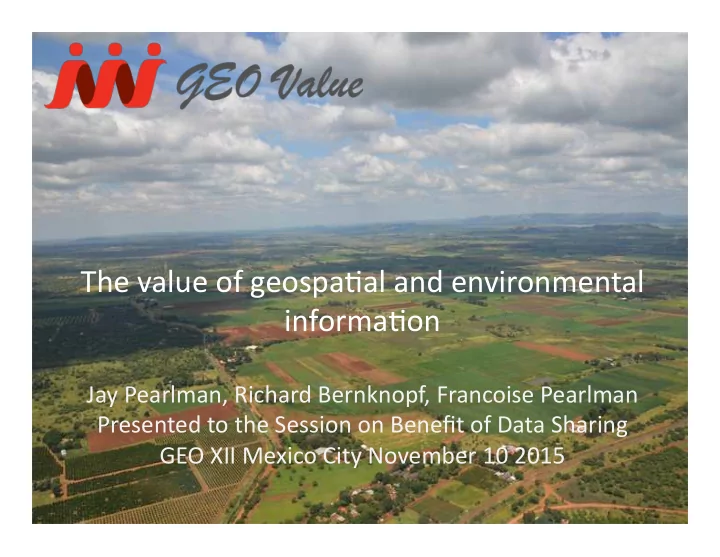

The value of geospa.al and environmental informa.on Jay Pearlman, Richard Bernknopf, Francoise Pearlman Presented to the Session on Benefit of Data Sharing GEO XII Mexico City November 10 2015
Economic Laws & Ecologic Regula0ons Social Domes0c DECISION or Morals Poli0cs & Ethics POLICY Interna0onal Science & Poli0cs Technology
Knowledge Informa.on Observe/ Wisdom Analyze Impact Decision
Observe/ Informa.on Knowledge Wisdom Decision Impact Analyze Technical Economic Social Poli.cal Domain Culture Language
Two Use Cases Case 1: Agriculture and Water Quality Case 2: Earthquake Hazards
Case 1: Agricultural produc.on and nutrient loading � EO provides the popula.on of land uses, while tradi.onal techniques focus on only a sample of land uses or a lower quality of informa.on � EO facilitates spa.otemporal analysis of the impact of nitrates on groundwater resources when couple with dynamic 3-D ground water models
Well capture zones and land use Corn (114.2 lb/acre of N) & soybean (3 lb/acre of N) are largest crops Completed for 350 wells in study area
Crop rota.on pa\erns and land uses using Landsat Data Waterloo USDA Cropland Data Layer based on MRLI provided corn & soybean produc.on es.mates for 2001 – 2010
Case 1: Summary � Over a 10-year period of analysis some groundwater wells are threatened by nitrate (NO3 -) contamination and could fail to maintain drinking-water quality in the next 10 years based on a three dimensional ground water model � Price x quantity of the crop that would have been planted had we not considered the water quality can be used as a baseline. Price of corn is much higher and may be preferred. Goal is to maximize the amount of corn without losing the water quality
An economic model of produc.on efficiency Produc.on efficiency and the produc.on possibility fron.er (PPF). The PPF represents produc.on tradeoffs of an economy given fixed resources. Movement from PPF 0 to PPF 1 is an increase in produc.vity. Movement along a PPF is a tradeoff between goods. Outcome: Estimated VOI for MRLI is an annualized $858M ± $197M / yr (in $2010) for northeastern Iowa A produc.on possibility curve for a technological innova.on in geospa.al data (source: Forney et al 2012)
Case 2: Pa\ern of expected damage to mul.family buildings in a M=7.8 earthquake scenario in southern CA (adding Social data) Southern CA scenario region Distribu.on of mul.family building damage and Regional distribu.on of mul.family building poverty by census tract in LA County; 42.2% of county damage es.mated at $2.9B popula.on in mul.-unit structures in 2000 Map of the USGS ShakeOut scenario in southern CA and mul.family building damage (Jones et al 2008) and census tracts with high levels of poverty in LA County (source: Bernknopf and Amos 2014)
Sta.s.cal indicator of earthquake risk concentra.on of building damage ranked by median household income (source: Bernknopf and Amos 2014) LA County results: Expected net benefit of voluntary mi0ga0on $1.1B ($0.4B) if mi0ga0on costs are 10% (50%) of • exposed real estate value 2,054 (2.6%) census tracts in LA County meet the income criterion for public investment (> 9% of • the popula0on below the poverty line) and would receive public investment in mi0ga0on
B/C and VOI mechanics where B tω ( i ) is the benefit at period t with informa0on ω ( i ), C t is the cost for period t , r is discount rate, VOI ω( 1) is the value of the new informa0on rela0ve to exis0ng informa0on , B ω( 1) is the net economic benefit of the new informa0on, and B ω( 0) is the net economic benefit with the exis0ng informa0on
Challenges encountered when analyzing impacts (from OECD) • No direct link between investment and impact • No single framework for assessment • Lack of iden.fica.on of users • Lack of appropriate indicators • Complex transfer mechanisms (between government, businesses, academia) • Na.onal vs interna.onal programs • Subjec.vity of non-economic impacts valua.on • Time lag (it takes .me to impact society) • Accoun.ng for changes in data policies
Challenges for Broad Applica.ons • Geospa.al data is an Intermediate good • Geospa.al informa.on value is determined on its impact on final goods – The demand for geospa.al informa.on is to reduce decision uncertainty – The economic value is an increase in produc.on efficiency • Determining the value requires an understanding of its use in producing the final good - crea.ng challenges to the crea.on of a broadly applied template for VOI
Workshop Oct 2014 Washington DC GEOValue Workshop - Data to Decisions: Valuing the Societal Benefits of Geospa.al Informa.on March 10, 11 2016 OECD Paris France
Thank you www.socioeconomicbenefits.org
Recommend
More recommend